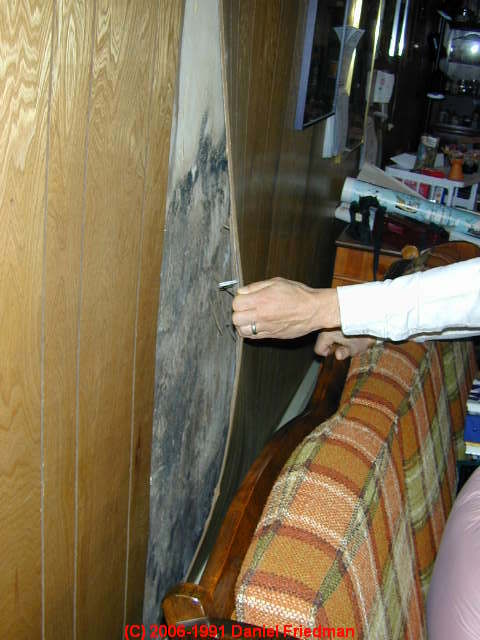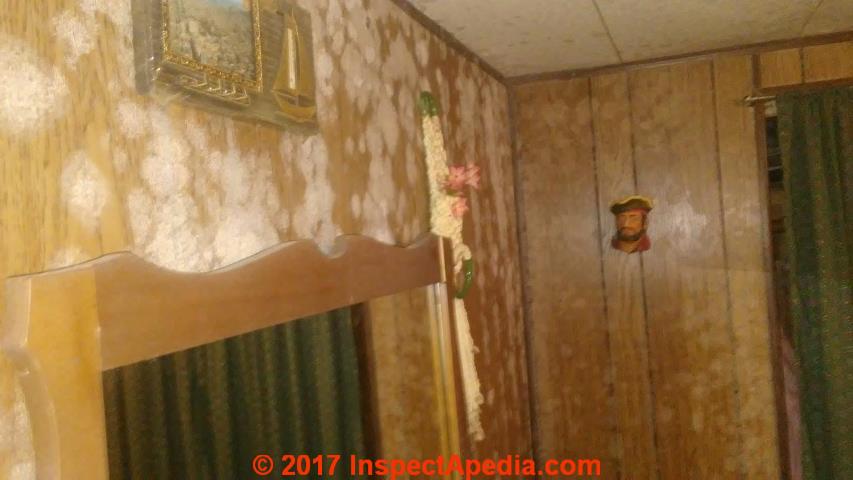 Find and Test for Mold on or Behind Wall Paneling
Find and Test for Mold on or Behind Wall Paneling
How to inspect behind paneling for hidden mold
Or remove paneling for complete inspection
- POST a QUESTION or COMMENT about visible & hidden mold growth on wood paneling in buildings: where it is found, how to spot it, how harmful it might be
Mold contamination hidden behind building wall or ceiling paneling:
The fact that mold is "hidden" in buildings does not mean one cannot find it.
We look by context: where do we see leak stains, or where do we see building practices most likely to have produced a hidden leak or moisture problem? Ice dam leaks in walls, hidden plumbing leaks, roof spillage by the foundation, are all common clues that often track to a wet building wall or ceiling cavity and from there to a hidden mold problem which may need to be addressed.
This document describes how to find mold and test for mold in buildings, including how and where to collect mold samples using adhesive tape - an easy, inexpensive, low-tech but very effective mold testing method.
This procedure helps identify the presence of or locate the probable sources of mold reservoirs in buildings, and helps decide which of these need more invasive, exhaustive inspection and testing.
InspectAPedia tolerates no conflicts of interest. We have no relationship with advertisers, products, or services discussed at this website.
- Daniel Friedman, Publisher/Editor/Author - See WHO ARE WE?
Hidden Mold Behind Paneling in Bathrooms and Basements

While we do not recommend wholesale demolition of rooms where there is no visible external mold, if an area has been wet by leaks or flooding, and where paneling covers walls (or ceilings) it is common to find problematic mold growth behind paneling even if it looks quite clean on the exposed or room side.
Some careful removal of sample panels in the most-suspect areas (most exposed to moisture or leaks) can disclose a hidden mold problem in a building.
If initial exploration for hidden mold shows what may be a large area of mold, say 30 sq .ft. or more of moldy surface, work should stop for professional evaluation and to avoid spreading moldy dust throughout the building.
All mold investigation work, demolition, and cleaning should be performed using the appropriate protective equipment.
Hidden mold example: removed bathroom paneling to expose hidden mold:
The photo above shows an extensive mold colony found growing on the face of drywall which had been covered by wainscot paneling in a bathroom.
More mold growth was on the hidden side of the paneling itself.
None of this mold was visible on the exposed bath surfaces before I pulled off this panel.
Why did I pull it down? There was evidence of a history of prior leaks in building walls and wet floors in this area.
Superficial cleaning and a "cover up"
installing new paneling was all that the building manager thought was required. Unfortunately it led to a greater cost
later to properly demolish and clean this area.
Remove basement paneling to expose hidden mold:
 In this photo of me pulling open the edge of basement paneling more than 20 years ago, we found that a large mold colony
had been generated on the drywall surface hidden behind the wood paneling.
In this photo of me pulling open the edge of basement paneling more than 20 years ago, we found that a large mold colony
had been generated on the drywall surface hidden behind the wood paneling.
Forty years previously, and 20 years before this inspection photo was taken, a single event basement flood had occurred. The owners had pumped out water and dried the basement within a few hours of the event.
There was almost no discernible clue on the exposed side of the paneling itself. Yet because the wall cavities themselves were not opened at the time of the flood, hidden surfaces and materials stayed wet long enough to initiate a large fungal colony.
It appears that once the mold colony was established, periodic elevations in basement humidity were enough to keep the mold colony happily growing along.
One of the home's occupants who grew up in this home developed severe asthma. She told me that if she simply stood at the top of the basement stairs above this room she would have an asthma attack.
Warning notice
Guidelines defining what's a "large amount" of mold and what's reasonable for a homeowner to handle have been published by several states including New York and California.
Links to some key documents describing mold cleanup and mold remediation procedures are
at CLEAN UP MOLD CONTAMINATION
People who are allergic, asthmatic, infant, elderly, immune-impaired, etc., should not disturb mold and should not be in the area where mold remediation is being performed. Consult with your doctor, health department or other professional before tackling this job yourself.
Below: white mold on paneling and on the ceiling of a mobile home, photos contributed by reader M.M.
In our opinion this is not a safe environment, and it is likely that there is additional water and mold damage behind the ceiling and wall surfaces.
The mobile home ceiling mold shown above is discussed further in a Q&A on distinguishing mold from stuff that is not mold, found
at MOLD APPEARANCE, STUFF THAT'S NOT MOLD - FAQs
...
Continue reading at HIDDEN MOLD in OTHER PLACES or select a topic from the closely-related articles below, or see the complete ARTICLE INDEX.
Or see these
Recommended Articles
- MOLD AGE, HOW OLD is the MOLD? - determining the age of mold contamination
- HIDDEN MOLD, HOW TO FIND - home
- LIGHT AIM FINDS MOLD & OTHER PARTICLES
- TEST CUTS for MOLD in BUILDING CAVITIES
- MOLD / ENVIRONMENTAL EXPERT, HIRE ?
- MOLD in BUILDINGS
- MOLD GROWTH on SURFACES for an index of what mold genera/species are frequently found on various building surfaces and materials.
Suggested citation for this web page
HIDDEN MOLD in PANELING at InspectApedia.com - online encyclopedia of building & environmental inspection, testing, diagnosis, repair, & problem prevention advice.
Or see this
INDEX to RELATED ARTICLES: ARTICLE INDEX to MOLD CONTAMINATION & REMEDIATION
Or use the SEARCH BOX found below to Ask a Question or Search InspectApedia
Ask a Question or Search InspectApedia
Try the search box just below, or if you prefer, post a question or comment in the Comments box below and we will respond promptly.
Search the InspectApedia website
Note: appearance of your Comment below may be delayed: if your comment contains an image, photograph, web link, or text that looks to the software as if it might be a web link, your posting will appear after it has been approved by a moderator. Apologies for the delay.
Only one image can be added per comment but you can post as many comments, and therefore images, as you like.
You will not receive a notification when a response to your question has been posted.
Please bookmark this page to make it easy for you to check back for our response.
IF above you see "Comment Form is loading comments..." then COMMENT BOX - countable.ca / bawkbox.com IS NOT WORKING.
In any case you are welcome to send an email directly to us at InspectApedia.com at editor@inspectApedia.com
We'll reply to you directly. Please help us help you by noting, in your email, the URL of the InspectApedia page where you wanted to comment.
Citations & References
In addition to any citations in the article above, a full list is available on request.
- In addition to citations & references found in this article, see the research citations given at the end of the related articles found at our suggested
CONTINUE READING or RECOMMENDED ARTICLES.
- Carson, Dunlop & Associates Ltd., 120 Carlton Street Suite 407, Toronto ON M5A 4K2. Tel: (416) 964-9415 1-800-268-7070 Email: info@carsondunlop.com. Alan Carson is a past president of ASHI, the American Society of Home Inspectors.
Thanks to Alan Carson and Bob Dunlop, for permission for InspectAPedia to use text excerpts from The HOME REFERENCE BOOK - the Encyclopedia of Homes and to use illustrations from The ILLUSTRATED HOME .
Carson Dunlop Associates provides extensive home inspection education and report writing material. In gratitude we provide links to tsome Carson Dunlop Associates products and services.



